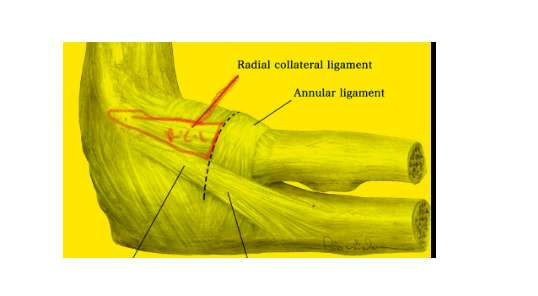Quick Overview of the
Radial Collateral Ligament, commonly abbreviated as RCL, is a pivotal ligament situated on the lateral (outer) side of the elbow joint. This ligament connects the humerus (the upper arm bone) to the radius (one of the two forearm bones), forming an essential part of the joint’s stability during various activities and movements.

Table of Contents
Anatomy of Radial Collateral Ligament
The Radial Collateral Ligament is a triangular ligament that originates from the lateral epicondyle of the humerus and inserts into the annular ligament of the radius. The annular ligament is a ring-like ligament that surrounds the head of the radius and helps to keep it in place.
Read also Coracohumeral Ligament and Ulnar Collateral Ligament
Functions of Radial Collateral Ligament
It has two main functions:
1- Stability: The RCL helps to stabilize the elbow and prevent it from moving too far inward (varus stress).
2- Guidance: The RCL helps to guide the elbow through its range of motion.
Radial Collateral Ligament Injuries
RCL injuries are common among athletes who participate in contact sports, such as football, rugby, and hockey. RCL injuries can also occur in people who do not participate in sports, but who frequently perform activities that involve repetitive overhead arm movements, such as painting or carpentry.
Types of Radial Collateral Ligament Injuries
Injuries to the Radial Collateral Ligament can range in severity and include:
- Sprains: Mild injuries involving stretching or slight tearing of the ligament.
- Partial Tears: More significant injuries where a portion of the ligament is torn.
- Complete Tears (RCL Rupture): Severe injuries in which the ligament is entirely torn.
Signs and Symptoms of RCL Injuries
Symptoms of RCL injuries may includes;
- Pain: Pain on the lateral side of the elbow, especially during activities that stress the joint.
- Swelling and Tenderness: Swelling and tenderness around the affected area.
- Weakness: Reduced grip strength and difficulty in performing tasks that require forearm rotation.
- Instability: A sense of instability or “giving way” of the elbow.
Diagnosis of RCL Injuries
RCL can diagnose injury by performing a physical examination and asking about the patient’s medical history and symptoms. The doctor may also order imaging tests, such as an X-ray or MRI, to confirm the diagnosis and assess the severity of the injury.
Treatment and Rehabilitation
Treatment options for RCL injuries vary depending on their severity and may include:
- Rest and Immobilization: Mild cases may heal with rest, bracing, and physical therapy.
- Surgery: Severe RCL tears may require surgical reconstruction.
- Rehabilitation: Physical therapy is essential to regain strength and function in the affected arm.
Prevention of RCL Injury
There are a few things you can do to prevent an RCL injury, including;
- Warming up before participating in physical activity
- Strengthening the muscles around the elbow
- Using proper form when performing activities that involve repetitive overhead arm movements
- Avoiding activities that aggravate the elbow
Questions
Q: What is the difference between a lateral epicondylitis (tennis elbow) and an RCL injury?
Lateral epicondylitis (tennis elbow) is a condition that causes pain on the outside of the elbow. It is most commonly caused by overuse of the muscles and tendons that attach the forearm to the elbow. An RCL injury is a tear of the radial collateral ligament, which is a ligament that helps to stabilize the elbow.
Q: How long does it take to recover from an RCL injury?
The recovery time for an RCL injury depends on the severity of the injury. Mild RCL sprains may heal within a few weeks, while more severe RCL sprains and RCL ruptures may take several months to heal.
Q: Can I still play sports after an RCL injury?
Yes, you can still play sports after an RCL injury, but it is important to follow your doctor’s instructions and gradually return to activity. It is also important to wear a brace or other supportive device to protect your elbow from further injury.
Q: What are the risks of surgery for an RCL injury?
Surgery for an RCL injury is generally safe and effective. However, there is a small risk of complications, such as infection, nerve damage, and stiffness.
Q: How can I prevent an RCL injury?
There are a few things you can do to prevent an RCL injury, including:
1- Warming up before participating in physical activity
2- Strengthening the muscles around the elbow
3- Using proper form when performing activities that involve repetitive overhead arm movements
4- Avoiding activities that aggravate the elbow
